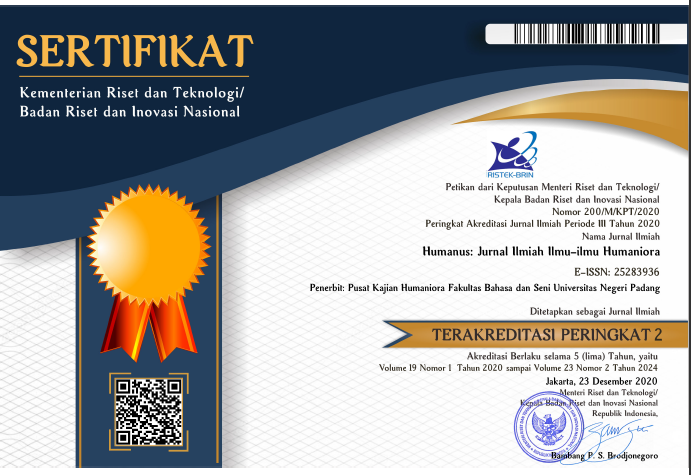VARIETY OF RHETORICS IN POLITICAL SPEECH PRESIDENT OF THE REPUBLIC OF INDONESIA SUSILO BAMBANG YUDHOYONO AND JOKO WIDODO IN EDUCATIONAL FIELD
 ), Emzir Emzir(2), Ninuk Lustyantie(3),
), Emzir Emzir(2), Ninuk Lustyantie(3), (1) STKIP PGRI Lubuklinggau, Indonesian Education Study Program
(2) Universitas Negeri Jakarta
(3) Universitas Negeri Jakarta
 Corresponding Author
Corresponding Author
Copyright (c) 2017 Humanus
DOI : https://doi.org/10.24036/humanus.v16i2.8103
Full Text:
 Language : en
Language : en
Abstract
The study aims to provide an understanding of the range of rhetoric in the political speech of the President of Indonesian Republic Susilo Bambang Yudhoyono and Joko Widodo, especially in the field of education. The research method used is the critical discourse analysis method of Norman Fairclough model. Data collection techniques used are documentation techniques, note-taking techniques, and interviews. Data analysis techniques are operated by connecting micro, meso, and macro elements in dimensions, such as: (a) text, (b) discourse practice, and (b) socio-cultural practices. The result of the research shows the rhetoric in the political speech of President Susilo Bambang Yudhoyono and Joko Widodo in the field of education which are compiled by the staf of presidential documents are as followed: 54,25% of the argumentation, 31,21% of the hortatory variety, 5,32% of the exposition, 4,25% of persuasion, 2,48% of informative variety, 1,06 % of narrative range, 0,71% of descriptive variation, 0,35% of dramatic variation, and 0,35% of procedural variation. The variety of rhetoric used aims to deliver educational programs that have been made, promises, and wishes or expectations to improve the quality of education in Indonesia, especially in the reform era.
Keywords: variety of rhetoric, state speech, education
RAGAM RETORIKA DALAM PIDATO KENEGARAAN PRESIDEN REPUBLIK INDONESIA SUSILO BAMBANG YUDHOYONO DAN JOKO WIDODO PADA BIDANG PENDIDIKAN
Abstrak
Penelitian ini bertujuan memberikan pemahaman tentang ragam retorika dalam pidato kenegaraan Presiden Republik Indonesia Susilo Bambang Yudhoyono dan Joko Widodo khususnya dalam bidang pendidikan. Metode penelitian menggunakan metode analisis wacana kritis model Norman Fairclough. Teknik pengumpulan data menggunakan teknik dokumentasi, teknik catat, dan wawancara. Teknik analisis data dengan cara menghubungkan unsur mikro, meso, dan makro pada dimensi: (a) teks, (b) praktik wacana, dan (b) praktik sosial budaya. Hasil penelitian menunjukkan ragam retorika yang terdapat dalam pidato kenegaraan Presiden Susilo Bambang Yudhoyono dan Joko Widodo dalam bidang pendidikan yang disusun bersama tim kerjanya, yaitu ragam argumentasi terdapat 54,25%, ragam hortatori terdapat 31,21%, ragam eksposisi terdapat 5,32%, ragam persuasi terdapat 4,25%, ragam informatif terdapat 2,48%, ragam narasi terdapat 1,06%, ragam deskriptif terdapat 0,71%, ragam dramatik terdapat 0,35%, dan ragam prosedural terdapat 0,35%. Ragam retorika yang digunakan bertujuan untuk menyampaikan program pendidikan yang telah dilakukan, janji, dan keinginan atau harapan untuk memperbaiki mutu pendidikan di Indonesia khususnya pada era reformasi.
Kata kunci: ragam retorika, pidato kenegaraan, bidang pendidikanKeywords
References
Baryadi, I. P. (2002). Dasar-dasar analisis wacana dalam ilmu bahasa. Yogyakarta: Gondosuli.
Budd, K. (2016). Analysing political speeches: rhetoric, discourse and metaphor. Critical Discourse Studies. 13 (1), 140.
David, M. K. (2014). Language, power and manipulation: the use of rhetoric in maintaining political influence. Frontiers of Language and Teaching. 5 (1), 167.
Fairclough, N. (1995). Critical discourse analysis: the critical study of language. London and New York: Longman.
Humaidi, A. (2016). Struktur teks, kognisi sosial, dan dimensi sosial pidato Susilo Bambang Yudhoyono. Jurnal Bahasa Sastra dan Pembelajarannya, Prodi. Magister Pend. Bahasa & Sastra Indonesia, Universitas Universitas Lambung Mangkurat. 6 (1), 115-127.
Keith, W. & Lundberg, C. O. (2008). The essential guide to rhetoric. New York: Bedford/St. Martin's.
Latif, L. A. (2016). Analysing political speeches: rhetoric, discourse and metaphor. Metaphor and Symbol, 31 (4), 250.
Noermanzah. (2016). Sermon rhetoric patterns of President Joko Widodo’s oration in the occasion of Bung Karno's oration on June 1, 1945 commemoration. Journal of Indonesian Language Education and Literary (JILEL). 1 (2). 17.
Rakhmat, J. (2014). Retorika modern (pengantar pertama retorika modern), sebuah kerangka teori dan praktik berpidato. Bandung: Angkasa.
Ricky, H. (2016). Perbandingan retorika Prabowo Subianto dan Joko Widodo dalam debat calon presiden 2014 (studi kasus retorika debat calon presiden 2014 mengenai pembangunan ekonomi dan kesejahteraan sosial), from NetLibray: http://e-journal.uajy.ac.id/6444/.
Rinaldi, R. (2017). Rhetoric dan figure of speech Minangkabau locality in Tonil Sabai Nan Aluih karya Sutan Sati. Humanus: Jurnal Ilmiah Ilmu-Ilmu Humaniora. XVI (2), 119.
Warburton, E. (2016). Jokowi and the new developmentalism. Bulletin of Indonesian Economic Studies. 52 (3), 317.
Winkler, A. C. & McCueen, J. R. (1974). Rhetoric made plain: third edition. New York: Harcourt Brace Jovanovich, Inc.
Zarefsky, D. (2005). Argumentation: the study of effective reasoning, 2ND edition. Virginia: The Great Courses.
 Article Metrics
Article Metrics
 Abstract Views : 1754 times
Abstract Views : 1754 times
 PDF Downloaded : 511 times
PDF Downloaded : 511 times
Refbacks
- There are currently no refbacks.
Copyright (c) 2017 Humanus

This work is licensed under a Creative Commons Attribution-NonCommercial 4.0 International License.










